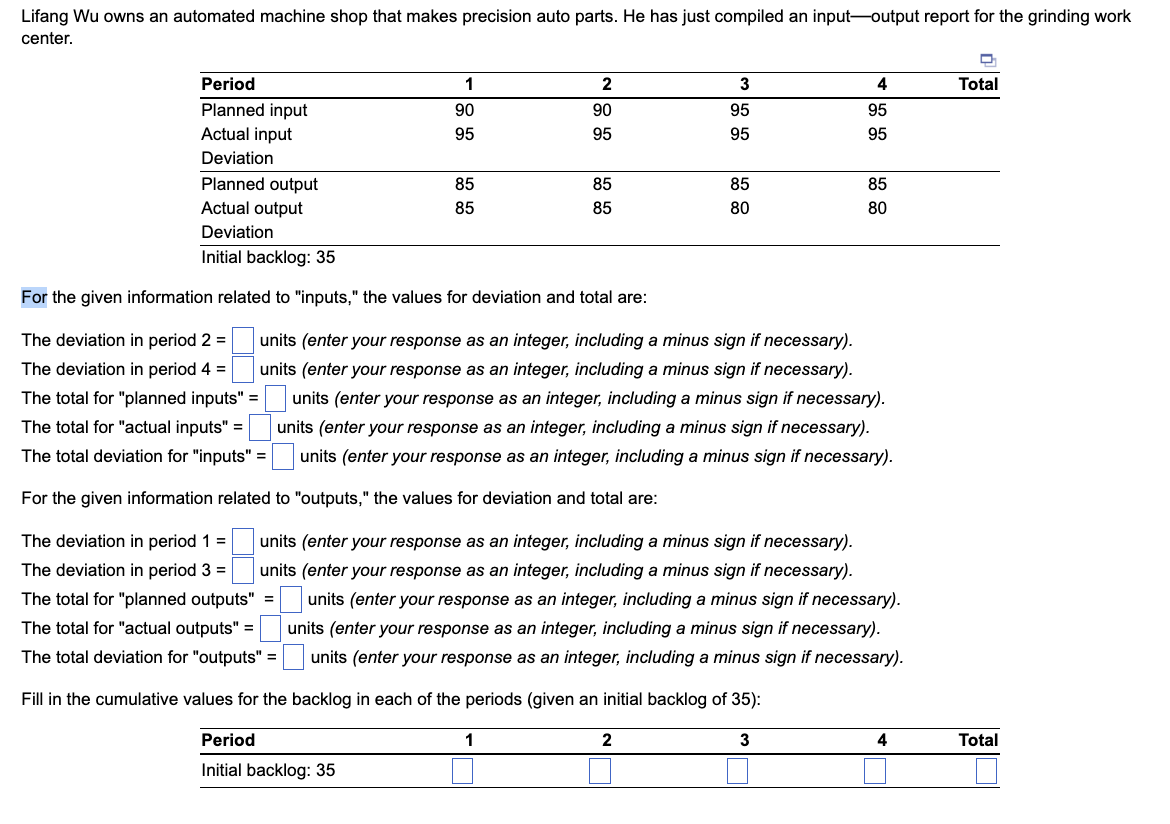Lifang Wu owns an automated machine shop that makes precision auto parts. He has just compiled an input-output report for the grinding work center. Period Planned input Actual input Deviation Planned output Actual output Deviation Initial backlog: 35 For the given information related to "inputs," the values for deviation and total are: 1 90 95 85 85 Period Initial backlog: 35 2 90 95 85 85 The deviation in period 2 = The deviation in period 4 = The total for "planned inputs" = The total for "actual inputs" = The total deviation for "inputs" = For the given information related to "outputs," the values for deviation and total are: The deviation in period 1 = The deviation in period 3 = The total for "planned outputs" The total for "actual outputs" = The total deviation for "outputs" = Fill in the cumulative values for the backlog in each of the periods (given an initial backlog of 35): 3 1 3 95 95 85 80 units (enter your response as an integer, including a minus sign if necessary). units (enter your response as an integer, including a minus sign if necessary). units (enter your response as an integer, including a minus sign if necessary). units (enter your response as an integer, including a minus sign if necessary). units (enter your response as an integer, including a minus sign if necessary). 2 4 95 95 units (enter your response as an integer, including a minus sign if necessary). units (enter your response as an integer, including a minus sign if necessary). units (enter your response as an integer, including a minus sign if necessary). units (enter your response as an integer, including a minus sign if necessary). units (enter your response as an integer, including a minus sign if necessary). = 85 80 4 D Total Total
Lifang Wu owns an automated machine shop that makes precision auto parts. He has just compiled an input
—output report for the grinding work center.
|
Period |
1 |
2 |
3 |
4 |
Total |
|
Planned input |
90 |
90 |
95 |
95 |
|
|
Actual input |
95 |
95 |
95 |
95 |
|
|
Deviation |
|
|
|
|
|
|
Planned output |
85 |
85 |
85 |
85 |
|
|
Actual output |
85 |
85 |
80 |
80 |
|
|
Deviation |
|
|
|
|
|
|
Initial backlog:
35 |
|
|
|
|
|
Part 2
For the given information related to "inputs," the values for deviation and total are:
The deviation in period 2 =
enter your response here
units (enter your response as an integer, including a minus sign if necessary).
Part 3
The deviation in period 4 =
enter your response here
units (enter your response as an integer, including a minus sign if necessary).
Part 4
The total for "planned inputs" =
enter your response here
units (enter your response as an integer, including a minus sign if necessary).
Part 5
The total for "actual inputs" =
enter your response here
units (enter your response as an integer, including a minus sign if necessary).
Part 6
The total deviation for "inputs" =
enter your response here
units (enter your response as an integer, including a minus sign if necessary).
Part 7
For the given information related to "outputs," the values for deviation and total are:
The deviation in period 1 =
enter your response here
units (enter your response as an integer, including a minus sign if necessary).
Part 8
The deviation in period 3 =
enter your response here
units (enter your response as an integer, including a minus sign if necessary).
Part 9
The total for "planned outputs" =
enter your response here
units (enter your response as an integer, including a minus sign if necessary).
Part 10
The total for "actual outputs" =
enter your response here
units (enter your response as an integer, including a minus sign if necessary).
Part 11
The total deviation for "outputs" =
enter your response here
units (enter your response as an integer, including a minus sign if necessary).
Part 12
Fill in the cumulative values for the backlog in each of the periods (given an initial backlog of
35):
|
|
|
|
|
|
|
|
|
|
|
|
|
|

Step by step
Solved in 3 steps with 2 images


